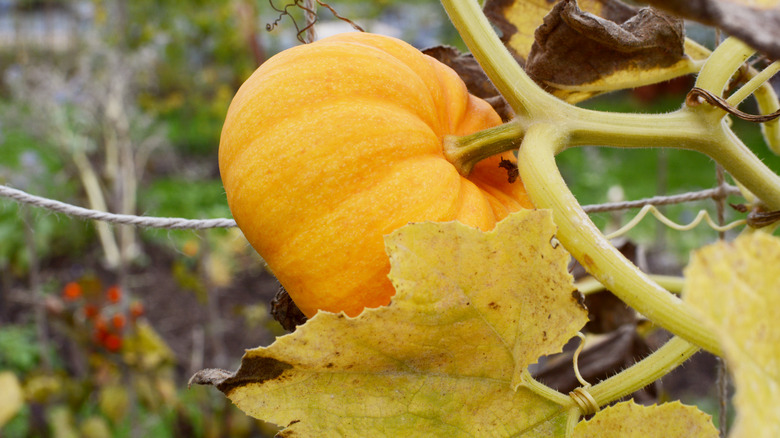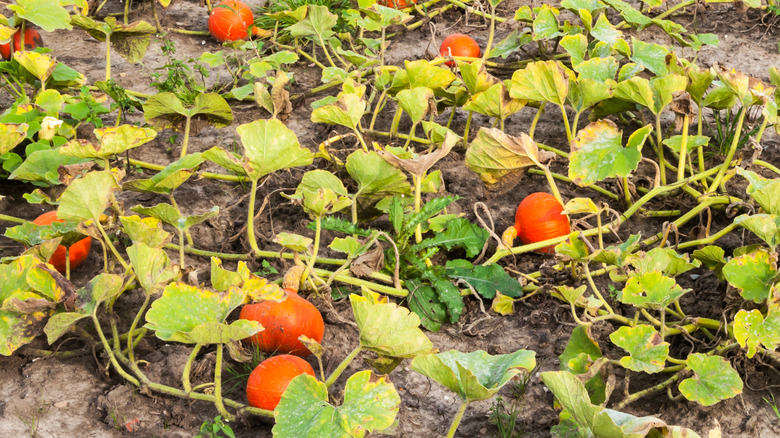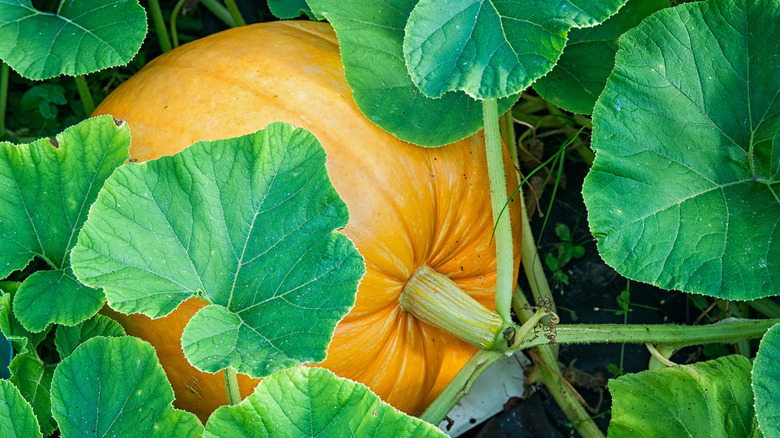Here's Why Your Pumpkin Plant Leaves Are Turning Yellow
Pumpkins are the quintessential autumn crop, capable of serving many purposes for families during the chilly months of October and November. While traveling to a pumpkin patch and choosing the perfect gourd often adds to the fall experience, growing and harvesting your own pumpkins is a great way to make use of extra space in your yard and spend more family time outdoors, so long as your home climate and homeowner's association allow. Pumpkins are fairly easy to grow even for gardeners with little experience, but this doesn't make the crops completely immune to the elements and other dangers to their health and safety. If you've noticed the leaves of your pumpkins change from green to yellow, you've likely already witnessed your plants signaling for help. Pumpkin leaves primarily turn yellow due to a lack of hydration or other key nutrients needed for survival.
Yellow leaves can also serve as a warning sign of impending disease, infestation, or hazardous environmental conditions. In other words, yellowing pumpkin leaves alert farmers and gardeners when external forces threaten to harm or kill their crop. The most vigilant and dedicated gardeners may notice these warning signs immediately, wasting no time in wiping out the source of the problem and saving their gourds. However, allowing the issue to continue and spread may risk stunting your crop, if not killing it altogether. Here's more on the reasons behind yellowing pumpkin leaves and the actions you can take to restore your harvest.
Why pumpkin leaves turn yellow
Just like many other plants, pumpkins need specific amounts of sunlight, water, and nutrients in order to grow to their fullest and strongest. Exceeding or failing to meet these limits may result in a lackluster harvest or, in more extreme cases, the crop dying before even having the chance to grow to maturity. Pumpkin leaves can also begin to yellow when experiencing excessive heat, cold weather, drought, a lack of nutrients, or threats from pests or diseases. Though, yellow leaves aren't always indicative of underlying issues with your crop. Pumpkin leaves may change color as they age, signifying it's time for them to die off and make room for new leaves. However, if a majority of your plant's leaves begin sporting yellow spotting — including young leaves — there may be a threat, or multiple threats, looming that you should turn your attention to.
Luckily for gardeners, pumpkins will likely notify you when they sense approaching danger. This change in color, which usually starts in the leaves before making its way to the fruits themselves, is typically one of the initial warning signs alerting you that something is interfering with your pumpkin's growth and overall condition. However, because yellowing leaves could suggest a variety of problems with your crop, it may be difficult to pinpoint what your plants are lacking in order to revert them back to green. Analyzing your home's climate and pumpkin's growing conditions may be an effective place to start.
How to save your pumpkins
Pumpkins grow best in warm climates and in soil that is rich and teeming with nutrients like organic matter. If the leaves are turning yellow, this may be a sign that you need to add more nutrients to the soil. Additionally, they can also be sensitive to drastic weather changes. If you're trying to grow big, healthy pumpkins in an environment prone to cold fronts and freezing temperatures like the American Northeast, establish the habit of covering your crop with newspaper or a blanket at night to prevent frost from killing your plants. Pumpkins also respond poorly to excessive heat, so gardeners in areas susceptible to heat waves should apply temporary shade or a layer of mulch atop the crop's soil to protect the fruits during the hottest times of day.
Once pumpkins begin to take root, caring for them becomes relatively simple, but they'll need plenty of water to mature properly. Make sure to give pumpkins at least an inch of water each week, irrigating them frequently while they're young and less often once they reach maturity. These plants are also highly susceptible to pests and disease, an issue that commonly stems from overwatering your crop. Inspect your gourds no less than once a week and check for mildew, bacteria, and insects looking to make a meal out of your garden. Fight back against these enemies with neem oil, fungicides, and insecticides.


